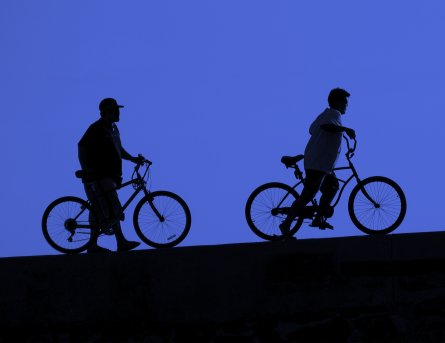
Before social networking, we had networking. By definition, networking is an interconnected system of people or things. Although it was originally a way for people to make friends and share interests, networking morphed into a buzzword in the business world. It became something one did to get a dream job or to get a promotion at their current job.
In both cases, networking was done, for the most part, in person. People set up lunch dates or met to engage in activities together. If they couldn’t meet in person, they chatted on the phone. They had conversations using their voices. Each party listened and spoke. It was a human exchange based on the human senses of seeing, hearing, and speaking.
This is what life was like among cyclists before the age of the Internet. The local bike shop was often a hangout for cyclists. There they could look at and discuss equipment. They could also share information about good routes or trouble spots.
Most shops had a display rack of local maps geared towards cyclists. Using a piece of paper, one cyclist could describe to another what a route was like, how difficult it was to ride, and the estimated number of cyclists and cars which traveled that route.
Vivid descriptions of rides were the norm. It was like sharing adventures with people who could relate to what you were experiencing. A lot of exaggeration was expressed, but that was part of the fun of hanging out with other cyclists. Yes, at that time, people “hung out” with one another.
They shared the same space at the same time, aware of each other’s physical presence. Reactions were instantaneous and understood. Disagreements which escalated to a fevered pitch could be resolved in the moment where they dissipated and disappeared into oblivion.
Inevitably, new cyclists would get drawn into the group. Just hanging around would allow the regulars to become familiar with their name. A well-timed word here or there could make their presence known. And, as naturally as a caterpillar turns into a butterfly, a newbie would metamorphose into a regular. Anyone who liked cycling enough could eventually fit in.
Once one was a member of the group, invitations to group rides became the norm. Talking was one thing, but riding was another. The whole purpose of the cycling social network was to ride and to share the experience of riding with others who also rode.
Riding could be about competition; it could be about camaraderie. It could be about being different from the majority who were sedentary and intoxicated by oil dependence. It could be about fitness. It could be about environmentalism. But whatever it was to any given cyclist, it was always borne of one thing — the sheer joy of riding a bicycle.
Cycling social networking had a pulse back then. It lived and breathed in the physical presence of cyclists. And the cyclists themselves breathed cycling. Riding sustained them.
Then came the Internet. It changed everything. Some changes were good and others not so good.
Cycling social networking became about “sharing” cycling with strangers who electronically befriended one for some unknown reason. Cycling stories and adventures were replaced by sophisticated systems of making distant comparisons.
In the early days of the Internet, chat rooms were popular. Cyclists could wait in an empty chat room for other cyclists to arrive. Or they could arrange to meet in the chat room to simulate the conversations that used to take place in bike shops, homes, and on the road. This was something like a real life conversation in that participants typed their thoughts back and forth in turn. But unlike real life, the larger the number of participants, the harder it became to follow the conversation.
To accommodate larger numbers of people who wanted to interact in real time, social networking platforms were developed. Cyclists could continuously update their friends, using these platforms, and avail themselves of a variety of tools designed for sharing information. While this made it easier to connect with other cyclists, the connections lacked the depth found in the bonds forged among cyclists who lived and breathed cycling together in the physical world.
Much of what took place online was comparative in nature. Route times were compared. Training methods were compared. Tips were shared and tested for effectiveness. The only semblance of humanity came in the form of photos or videos posted online to put a face on a distant “friend.”
All of this evolved into the present. Now, we have cycling social networking sites were riders test their skills against one another using GPS devices. The fun stories cyclists used to tell about their exploits have been replaced by precise electronic measurements of their movements, uploaded to the Internet for all to see.
Cyclists compete with people they will probably never meet for titles such as “King of the Hill.” Posting one’s ride statistics has replaced sharing a ride with friends. The statistics have become the rider. And improving those statistics has become an obsession for many riders.
Too many cyclists have become little more than statistics on a screen. The human element of riding has been replaced by a desire to show others how well one rides. Riding for such cyclists is not a passion, it is an addiction — one which is fed remotely through frequent data transmissions. With this behavior becoming more common, it is no wonder that cyclists have developed a dehumanized reputation.
Regaining the lost humanity of cycling might help to make it a mainstream activity. Moving cycling social networking out of the electronic world and back into the physical world would make cyclists seem more human to non-cyclists who might then perceive them as entitled to compassion and consideration on the road. And, if not, it might make cycling more appealing to newcomers who will see a warm, social side to an activity which might otherwise have alienated them. In any event, humanizing cycling can’t hurt.


